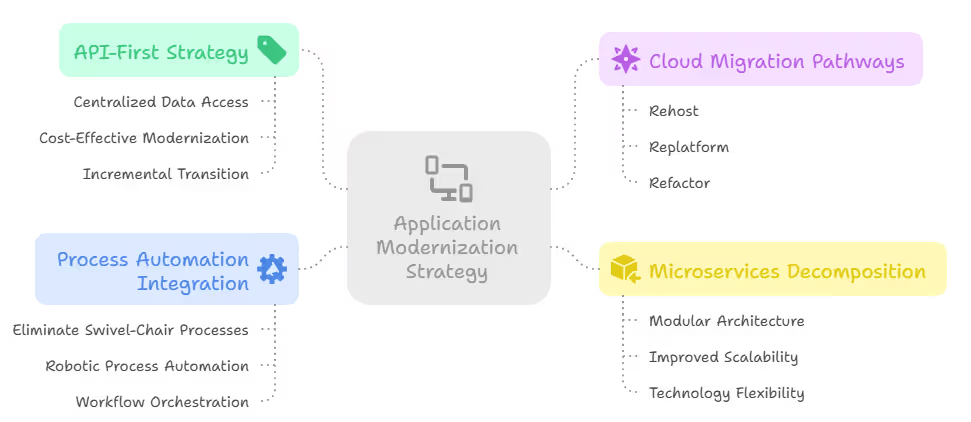Application Modernization Strategy to Drive Growth

Why Application Modernization Strategy Is Urgent
Application modernization strategy is urgent because outdated systems slow innovation, increase costs, and create security risks. Legacy applications often lack scalability and integration with modern technologies like cloud, AI, and automation, making businesses less competitive. As customer expectations evolve rapidly, organizations must deliver faster, more reliable digital experiences. Modernization enhances performance, reduces technical debt, and improves compliance with industry standards. It also enables agility, allowing businesses to adapt quickly to market changes.
Without modernization, companies risk falling behind more agile competitors, losing both efficiency and market share in today’s fast-moving digital economy.
Understanding Application Modernization Strategy
Application modernization Strategy is about reengineering outdated systems to align with today’s business demands and technological advancements.
It’s not just a “cloud migration” or a quick fix, it’s a holistic transformation to make your applications more flexible, efficient, and future-ready.
What Modernization Entails:
- Breaking Down Monoliths: Transitioning from rigid, monolithic architectures to modular microservices.
- Cloud-Native Shift: Moving from on-premises infrastructure to cloud platforms for scalability and cost efficiency.
- Modern Tech Stacks: Replacing obsolete frameworks with cutting-edge tools like React, Node.js, or serverless architectures.
- DevOps Integration: Adopting continuous integration/continuous deployment (CI/CD) for faster, more reliable delivery.
- AI and ML Enablement: Embedding artificial intelligence and machine learning to enhance automation and insights.
Modernization isn’t a one-size-fits-all process, it’s a tailored strategy to meet your organization’s unique needs.
Application Modernization Strategy for USA
Modernizing legacy systems requires a thoughtful, tailored strategy to balance cost, risk, and business value.
Below are expanded approaches with practical steps and examples to guide your modernization journey.

1. API-First Strategy
Wrapping legacy systems with APIs enables interoperability with modern platforms without requiring immediate replacement. This approach is ideal for systems that still deliver value but lack connectivity or flexibility.
- Centralized Data Access: APIs allow legacy systems to share data with modern applications, enabling seamless integration across the enterprise. For instance, a legacy CRM can feed customer data to a new analytics platform via REST APIs.
- Cost-Effective Modernization: By extending the life of functional systems, APIs reduce the need for costly rewrites. A retail company used APIs to connect its legacy inventory system to a modern e-commerce platform, cutting integration costs by 40%.
- Incremental Transition: APIs act as a bridge, allowing gradual modernization while maintaining operations. For example, a bank integrated its mainframe with a mobile app via APIs, improving customer access without disrupting core systems.
- Standardized Interfaces: Use tools like Swagger or OpenAPI to create consistent, reusable APIs that simplify future integrations.
- Security Considerations: Implement API gateways (e.g., Apigee, AWS API Gateway) to manage authentication, rate limiting, and monitoring for secure data exchange.
- Solution: Prioritize high-value integrations, start with well-documented APIs, and test extensively to ensure compatibility.
2. Cloud Migration Pathways
Moving on-premises applications to the cloud unlocks scalability, cost efficiency, and access to managed services. Choose from multiple migration strategies based on your needs.
- Rehost (Lift-and-Shift): Migrate applications to the cloud with minimal changes for quick wins. Ideal for stable systems needing infrastructure upgrades. A manufacturing firm rehosted its ERP on AWS EC2, reducing server costs by 20%.
- Replatform: Optimize applications for cloud-native features, such as managed databases or auto-scaling. For example, a financial services firm replatformed its app on AWS ECS, cutting infrastructure costs by 30%.
- Refactor: Redesign applications to leverage cloud-native capabilities like serverless or microservices. A SaaS provider refactored its app for AWS Lambda, improving scalability and reducing latency by 50%.
- Hybrid Cloud Approach: Combine on-premises and cloud environments for phased migrations, minimizing disruption. A healthcare company used Azure Hybrid to maintain sensitive data on-premises while scaling analytics in the cloud.
- Vendor Selection: Evaluate platforms (AWS, Azure, Google Cloud) based on cost, compliance, and feature alignment. Use tools like CloudHealth for cost optimization.
- Solution: Start with a cloud readiness assessment, prioritize low-risk migrations, and use cloud provider migration tools (e.g., AWS Migration Hub) for streamlined execution.
3. Microservices Decomposition
Breaking monolithic applications into smaller, independent microservices enhances agility, scalability, and maintainability.
- Modular Architecture: Decompose monoliths into discrete services (e.g., user authentication, payment processing) to enable independent development and deployment. A media company decomposed its CMS into microservices, reducing deployment times from weeks to hours.
- Improved Scalability: Scale individual services based on demand, unlike monoliths that scale as a single unit. For instance, an e-commerce platform scaled its checkout service during peak sales without over-provisioning other components.
- Technology Flexibility: Use different tech stacks for each microservice (e.g., Node.js for APIs, Python for analytics) to optimize performance.
- Fault Isolation: Failures in one microservice don’t impact others, improving reliability. A streaming service isolated its recommendation engine, ensuring uptime during updates.
- Implementation Tools: Use Kubernetes for orchestration and Istio for service mesh to manage microservice communication.
- Solution: Start with a single, low-risk module, use domain-driven design to define service boundaries, and monitor performance with tools like Prometheus.
4. Process Automation Integration
Automating manual processes within legacy systems boosts efficiency, reduces errors, and frees up resources for higher-value tasks.
- Eliminate Swivel-Chair Processes: Replace manual data entry or cross-system tasks with automation. A logistics firm automated order processing between its ERP and warehouse systems, saving 20 hours weekly and improving accuracy.
- Robotic Process Automation (RPA): Use tools like UiPath or Automation Anywhere to automate repetitive tasks, such as report generation or data validation.
- Workflow Orchestration: Implement tools like Apache Airflow to automate complex workflows, ensuring seamless data flow between legacy and modern systems.
- Cost and Time Savings: Automation reduces labor costs and accelerates processes. A bank automated compliance checks, cutting processing time by 60%.
- Scalable Automation: Integrate automation with cloud-native tools like AWS Step Functions for dynamic scaling and resilience.
- Solution: Identify high-impact manual processes, pilot automation with low-risk tasks, and scale successful automations across the organization.
Core Challenges in Application Modernization
Modernizing legacy systems is a complex endeavor with multifaceted challenges.
Below, we expand on the key hurdles IT leaders face, providing detailed insights and actionable considerations.
1. Legacy System Complexity
Legacy systems are often intricate, with decades of layered code and integrations creating a web of dependencies.
This complexity makes modernization a high-stakes puzzle.
- Interconnected Components: Monolithic systems have tightly coupled modules, where modifying one component risks destabilizing others. For example, updating a single database call in a legacy ERP system may break downstream processes.
- Lack of Documentation: Many legacy systems lack up-to-date documentation, leaving teams to reverse-engineer functionality, which slows progress and increases errors.
- Obsolete Technologies: Systems built on outdated platforms (e.g., Windows NT, Oracle Forms) are incompatible with modern tools like containers or serverless architectures.
- Hidden Dependencies: Undocumented integrations with third-party systems or internal tools can surface unexpectedly, derailing modernization efforts.
- Solution: Conduct a thorough dependency mapping using tools like CAST or Dynatrace to visualize system interactions before planning changes.
2. Technical Debt and Skills Gap
Technical debt accumulates from years of quick fixes, while a shortage of skilled developers creates a bottleneck for modernization.
- Accumulated Technical Debt: Workarounds and patches create fragile codebases, requiring significant refactoring before modernization can begin. For instance, a 2023 study found that 70% of enterprises cite technical debt as a top modernization barrier.
- Legacy Skill Shortages: Developers proficient in legacy languages like COBOL or Fortran are retiring, and younger talent focuses on modern stacks like Python or Go.
- Dual Expertise Gap: Modernization demands knowledge of both legacy systems and modern frameworks, a rare combination that drives up hiring costs.
- Knowledge Silos: Critical system knowledge often resides with a few long-tenured employees, posing risks if they leave.
- Solution: Invest in upskilling programs (e.g., via Pluralsight or Udemy) and document tribal knowledge. Partner with specialized consultancies to fill expertise gaps.
3. Business Continuity Risks
Modernization must not disrupt critical operations, as downtime or errors can lead to significant financial and reputational damage.
- Uptime Requirements: Mission-critical systems, like banking platforms, require 99.999% uptime, making migrations risky without robust failover plans.
- Data Integrity: Migrating large datasets risks corruption or loss, especially when moving to new formats or schemas.
- User Disruption: Changes to workflows or interfaces can confuse employees or customers, impacting productivity and satisfaction.
- Testing Challenges: Comprehensive testing across legacy and modern systems is resource-intensive but essential to avoid outages.
- Solution: Use blue-green deployments or canary releases to minimize disruptions, and prioritize incremental migrations starting with non-critical systems.
4. Integration and Data Migration Complexities
Integrating legacy systems with modern platforms and migrating data are fraught with technical challenges.
- API Incompatibilities: Legacy systems often lack modern APIs, requiring custom middleware to connect with cloud-native platforms.
- Data Consistency: Migrating data to new systems risks inconsistencies, such as mismatched formats or missing records. For example, moving from a legacy RDBMS to a NoSQL database can introduce schema conflicts.
- Performance Impacts: Integration layers can introduce latency, degrading user experience during transitions.
- Legacy Vendor Lock-In: Proprietary systems may limit data extraction, complicating migrations to open platforms.
- Solution: Implement API gateways (e.g., Apigee) and use ETL tools (e.g., Talend) to streamline data migration and ensure consistency.
5. Cultural and Organizational Resistance
Human factors can be as challenging as technical ones, as teams resist new processes or technologies.
- Resistance to Change: Developers comfortable with legacy workflows may resist adopting DevOps or microservices, fearing job disruption.
- Siloed Teams: Development, operations, and business units often work in isolation, hindering collaboration on modernization goals.
- Lack of Buy-In: Stakeholders may question modernization’s value without clear ROI communication.
- Skill Anxiety: Employees may feel intimidated by new tools like Kubernetes or CI/CD pipelines, slowing adoption.
- Solution: Foster a change-ready culture through training, clear communication of benefits, and early pilot projects to demonstrate value.
Essential Technologies for Modern Architectures
Building Your Modernization Roadmap
1. Assessment and Planning
Conduct a portfolio analysis to categorize applications:
- Retire: Obsolete systems.
- Replace: Systems needing full rewrites.
- Renovate: Systems suitable for refactoring.
2. Incremental Modernization
Start with low-risk applications to build expertise.
3. Technology Selection
Choose technologies based on business objectives, application complexity, and team skills.
- Example: A SaaS company adopted Kubernetes for its high-traffic app, improving uptime by 99.9%.
Measuring Success: KPIs and ROI Metrics
Technical Performance Indicators
- Response Time: Measure speed improvements.
- Uptime: Target 99.9%+ availability.
- Deployment Frequency: Aim for daily releases.
- MTTR: Reduce recovery time to minutes.
Business Impact Metrics
- Cost Savings: Track maintenance cost reductions.
- Developer Productivity: Measure time saved.
- Customer Satisfaction: Monitor NPS scores.
- Time-to-Market: Shorten feature release cycles.
Security and Compliance
- Vulnerability Reduction: Aim for 90%+ reduction.
- Compliance: Ensure 100% audit compliance.
Start Your Modernization Journey Today
Application modernization is a strategic necessity. By transforming legacy systems, you unlock scalability, reduce costs, and drive growth.
Next Steps:
- Assess Your Portfolio: Identify modernization candidates.
- Build a Roadmap: Prioritize incremental wins.
- Partner for Success: Engage experts to accelerate your journey.


